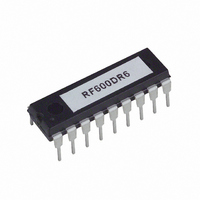RF600D RF Solutions, RF600D Datasheet - Page 19

RF600D
Manufacturer Part Number
RF600D
Description
IC DECODER RECEIVER RF 18DIP
Manufacturer
RF Solutions
Type
Decoderr
Datasheet
1.RF600E.pdf
(24 pages)
Specifications of RF600D
Applications
RF, IR
Mounting Type
Through Hole
Package / Case
18-DIP (0.300", 7.62mm)
Supply Voltage Range
4.5V To 5.5V
Digital Ic Case Style
DIP
No. Of Pins
18
Filter Terminals
SMD
Ic Generic Number
600
Available stocks
Company
Part Number
Manufacturer
Quantity
Price
DS600-10 March ‘06
HiRK decoder area.
Power supply area.
The radio keyfob is a standard R. F. Solutions AM-110C3-433 keyfob which contains an RF600E encoder
chip and also an AM radio transmitter circuit. Three push buttons allow the user to send commands to the
RFEVAL2 board where the signals will be received and decoded.
The RFEVAL2 board is supplied with a circuit diagram and also a parts list and can be used for a wide
range of development tasks including the following.
Remote switching - software and hardware systems can be simply prototyped and tested.
Range and environment testing - these initial stages of project design can be carried out and valuable
results obtained without the expense of PCB design and procurement.
Solve the great AM/FM question - the low cost of AM modules must be balanced with their lower
performance when compared to FM and accurate comparisons of performance can be carried out with this
board.
Aerial test - the transmitter board has provision for both AM and FM modules and can be fitted with helical
stub and 1/4 wave whip aerials, thus allowing module and aerial performance to be tested and optimised.
RF Input Circuit.
The RF input stage of the RFEVAL2 board can be implemented using either a radio receiver module or
alternately using the composite hybrid receiver / decoder HiRK module.
The can accept up to 3 radio modules and each module has an associated pair of option links. One of
these couples the +5 volt supply to the module and the other allows for the connection of the ‘data out’
signal to the decoder IC. The need for a +5 volt option link may not be immediately apparent but most
radio receivers are in practice transmitters as well and radiate from their local oscillator stage. If these
signals are picked up by a nearby receiver then they may well cause distortion of incoming ‘real’ signals or
in extreme cases my completely prevent operation of the receiver. The four modules which may be fitted
to the board are as follows.
FM-RRFQ1 FM module (M3) which receives signals from a compatible FM transmitter module such as the
FM-RTFQ1. Operation is possible at data rates up to 4.8Kbps and at distances up to 250 metres over
open ground.
AM-HRR3 AM module (M4) which receives signals from a compatible AM transmitter module such as the
AM-RT4 or AM-RT5. These modules will operate at up to 4 Kbps and over a range of up to 500 metres.
The super-regenerative circuit used, results in a low cost device with adequate performance for many
short range applications. Note that this module position will accept RRS3 modules which utilise a superhet
circuit to give improved performance and range over the HRR3 devices.
Irrespective of how many modules are fitted, it will be necessary to connect the +5 volt and data lines of
one module using the link options filed on the PCB. It is important that only one pair of links be made at
RF / IR Encoder / Decoder Chipset
RF Evaluation Boards,
AM-HiRK-433 receiver/decoder module.
Learn switch.
Learn LED.
Data LED’s.
5 volt regulator.
Supply indicator
©2004 Reg. No. 227 4001, ENGLAND
(U5)
(M5)
(SW2)
(LED7)
(LED8, 9, 10)
(LED11)
Page 19
RF600E
RF600D



















